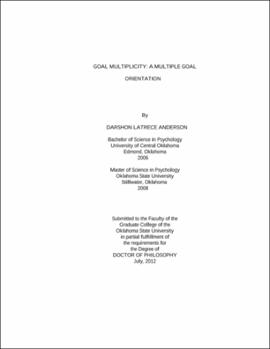| dc.contributor.advisor | Burkley, Edward | |
| dc.contributor.author | Anderson, Darshon LaTrece | |
| dc.date.accessioned | 2013-11-26T08:27:35Z | |
| dc.date.available | 2013-11-26T08:27:35Z | |
| dc.date.issued | 2012-07 | |
| dc.identifier.uri | https://hdl.handle.net/11244/6927 | |
| dc.description.abstract | Scope and Method of Study: | |
| dc.description.abstract | Previous research has examined concepts such as goal systems, networks, and resource allocation in multiple-goal pursuit but one area that has received little attention is goal orientation. The present research discusses the development of the Goal Multiplicity Scale (GM) using an Exploratory and Confirmatory Factor Analysis followed by a behavioral validation study using an experimental design. The GM scale assesses an individual's proclivity to pursue multiple goals simultaneously in order to meet all goals. | |
| dc.description.abstract | Findings and Conclusions: | |
| dc.description.abstract | The development and testing of the Goal Multiplicity Scale was reported (Study 1 & 2), followed by a validation test to support the outlined construct (Study 3). The results from study 1 suggest Goal Multiplicity can be captured via self-report and is a two-dimensional trait. Results from the Confirmatory Factor Analyses suggested moderate fit of the data to the 2-factor model. In spite of problematic study 2 did find significant correlations with multi-tasking, action-control, and need for cognition, which emphasize personality traits that affect multiple goal pursuit strategies. With plans to extend current research in the area of multiple goal pursuit, study 3 anticipated differences would be found in task performance for people who have a preference for a particular goal orientation but are placed in situations that do not "fit" their goal orientation. No evidence for this hypothesis was found in the behavioral validation study. | |
| dc.description.abstract | The concept of Goal Multiplicity showcases how personality variables such as need for cognition and multitasking interact with situational variables such as job requirements and time that produce individual differences in goal pursuit strategies. This work is not only needed but necessary in order to extend and build upon previous research that has shown individuals can balance conflicting goal pursuits without sacrificing or giving up on any of them. The first step of extending this work has been completed with the development of the Goal Multiplicity Scale. However, revisions and modifications of the scale are necessary. This work has implications for goal achievement in that it can shed light upon both personality and situational factors that affect goal pursuits. | |
| dc.format | application/pdf | |
| dc.language | en_US | |
| dc.rights | Copyright is held by the author who has granted the Oklahoma State University Library the non-exclusive right to share this material in its institutional repository. Contact Digital Library Services at lib-dls@okstate.edu or 405-744-9161 for the permission policy on the use, reproduction or distribution of this material. | |
| dc.title | Goal multiplicity: A multiple goal orientation | |
| dc.contributor.committeeMember | Burkley, Melissa | |
| dc.contributor.committeeMember | Grant, Demond | |
| dc.contributor.committeeMember | Baron, Robert | |
| osu.filename | Anderson_okstate_0664D_12250.pdf | |
| osu.accesstype | Open Access | |
| dc.type.genre | Dissertation | |
| dc.type.material | Text | |
| dc.subject.keywords | goal conflict | |
| dc.subject.keywords | goal orientation | |
| dc.subject.keywords | goals | |
| dc.subject.keywords | multiple goal pursuit | |
| thesis.degree.discipline | Psychology | |
| thesis.degree.grantor | Oklahoma State University | |
